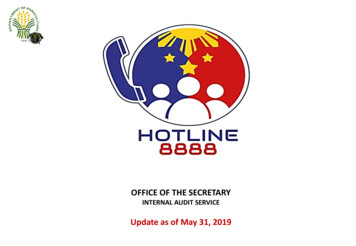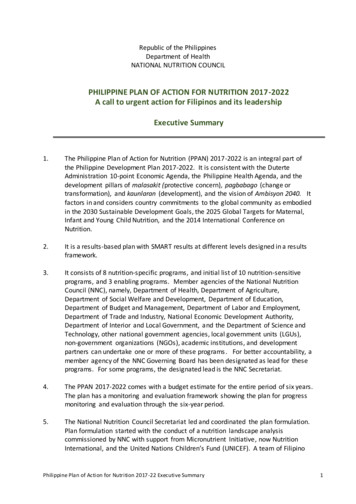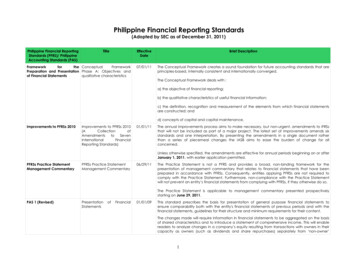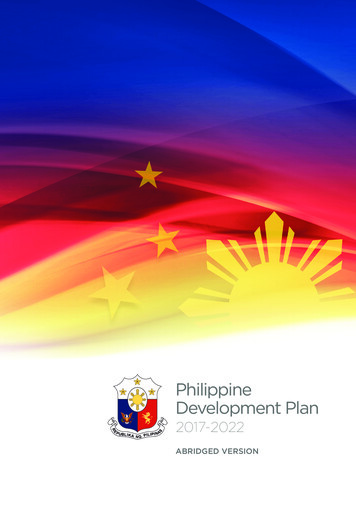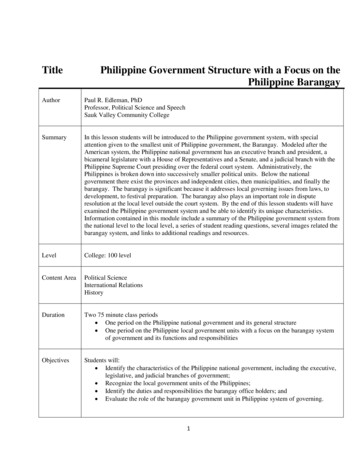
Transcription
Land grabbing, conflict and agrarian‐environmental transformations:perspectives from East and Southeast AsiaAn international academic conference5‐6 June 2015, Chiang Mai UniversityDiscussion Note No. 2Philippine Agrarian Reform in the 21st CenturyEduardo Climaco TademMay 2015BICASwww.plaas.org.za/bicaswww.iss.nl/bicasIn collaboration with:Demeter (Droits et Egalite pour une Meilleure Economie de la Terre), Geneva Graduate InstituteUniversity of Amsterdam WOTRO/AISSR Project on Land Investments (Indonesia/Philippines)Université de Montréal – REINVENTERRA (Asia) ProjectMekong Research Group, University of Sydney (AMRC)University of Wisconsin-MadisonWith funding support from:
Philippine Agrarian Reform in the 21st Centuryby Eduardo Climaco TademPublished by:BRICS Initiatives for Critical Agrarian Studies (BICAS)Email: bricsagrarianstudies@gmail.comWebsites: www.plaas.org.za/bicas www.iss.nl/bicasMOSAIC Research ProjectWebsite: www.iss.nl/mosaicLand Deal Politics Initiative (LDPI)Email: landpolitics@gmail.comWebsite: www.iss.nl/ldpiRCSD Chiang Mai UniversityFaculty of Social Sciences, Chiang Mai University Chiang Mai 50200 THAILANDTel. 66 53 943595/6 Fax. 66 53 893279Email : rcsd@cmu.ac.th Website : http://rcsd.soc.cmu.ac.thTransnational InstitutePO Box 14656, 1001 LD Amsterdam, The NetherlandsTel: 31 20 662 66 08 Fax: 31 20 675 71 76E mail: tni@tni.org Website: www.tni.orgMay 2015Published with financial support from Ford Foundation, Transnational Institute, NWO and DFID.
AbstractIn June 2015, the Philippine government’s agrarian reform law reached its 27th year of implementation(including a 16-year extension period) with completion nowhere in sight. The government’sComprehensive Agrarian Reform Program (CARP) and its extension, the Comprehensive AgrarianReform Program Extension with Reforms (CARPER) had provisions that were generally favorable totheir intended beneficiaries. But CARP/ER was also essentially the result of a compromise betweenpro and anti-agrarian reform blocs in the Philippine Congress and thus also contained provisionsinserted by landowner lobbyists that are considered loopholes in the law. The program is furtherhampered by an ineffectual bureaucracy, rampant land conversions and displacements of peasantcommunities, incursions of property developers, other rent-seekers, and special economic zones, andthe expansion of urbanization into the countryside.
IntroductionIn June 2014, the Philippine government’s agrarian reform law reached its 26th year of implementation(including a 16-year extension period) with completion nowhere in sight. The ComprehensiveAgrarian Reform Program (CARP) and its extension, the Comprehensive Agrarian Reform ProgramExtension with Reforms (CARPER) had provisions that were generally favorable to their intendedbeneficiaries. But CARP/ER was also essentially the result of a compromise between pro and antiagrarian reform blocs in the Philippine Congress and thus also contained provisions inserted bylandowner lobbyists that are considered loopholes in the law.Agrarian Reform’s Core PrinciplesThe basic principles of a genuine, meaningful and sustainable agrarian reform program are enshrinedin the long history of agrarian unrest and rural social movements that have punctuated the country’sexperience since colonial times. In the current era, they are best exemplified by the Declaration ofPrinciples adopted in May 1987 by the Congress for a People’s Agrarian Reform (CPAR) whichbecame the highest expression of peasant, farm worker, and fisher folk unity immediately after theouster of the Marcos dictatorship in 1986. CPAR consisted of twelve (12) major rural national andregional mass organizations and fourteen (14) non-governmental support groups from all sections ofthe political spectrum. The CPAR declaration asserted that:The core principle in agrarian reform is the primacy of the right of all members of the agriculturallabor force who do not own land, near-landless farmers, farmworkers, small fisherfolk and other directproducers to own and control the land, have full access to other natural resources and gain fulldisposition over the produce (CPAR Declaration of Principles, 31 May 1987).In this regard, the major issues are (1) social justice and inequality, (2) low productivity, (3) lackof control by the rural masses over their lives and destiny, (4) under-industrialization, (5)environmental breakdown, and, (6) foreign domination. CPAR also outlined the aims of its agrarianreform program:1. To transfer landed wealth and power over the land and its produce to the actual tillers2. To free and develop the productive powers of agrarian workers, and fisherfolk form the forcesthat deprive them of resources and initiative3. To develop the mechanisms for people empowerment by creating autonomous decision-makingbodies of the rural masses4. To promote nationalist industrialization by widening the national market, rechanneling theagricultural surplus into industrial investments and labor for industrial development, and theestablishment of self-sufficient local industries controlled by the rural masses5. To conserve the natural environment so that it may serve the short and long-term needs of theFilipino people6. To do away with foreign control over natural resourcesWhen a disappointing CARP law (RA 6657) was finally enacted by then President CorazonAquino in June 1988, an indignant CPAR issued the “People’s Agrarian Reform Code” (PARCODE)in the same month as a counter-program and direct initiative measure with the following basiccomponents:1. Land to the tiller" and abolition of "absentee landownership ,"1
2. Full coverage of all types of agricultural lands and all types of direct producers,3. Progressive and selective compensation for landowners,4. All previous land rentals and uncompensated labor be credited as advance payments for the landby beneficiaries.5. Full participation by beneficiaries in the formulation and implementation of the program,6. Preferential option for cooperatives and collective farms,7. Equal rights to land ownership for women producers,8. Filipinization of all lands utilized by multinational corporations,9. Preferential rights of small fisherfolk to fishing resources,10. Respect for the rights of indigenous communities over their ancestral lands and all other naturalresources and fishery resources11. Implementation of just labor relations for farmworkers.These then are the basic principles and features of an agrarian reform program that meets the trueneeds and deep aspirations of the Filipino peasantry and other rural working classes. When measuredagainst what CARP/ER has had to offer, CPAR and PARCODE definitely represent the more superioralternative.Economist Lourdes Adriano (1991)1 said as much in declaring that, “PARCODE is superior toCARP” since (1) “in terms of area coverage it is more comprehensive” (2) “it does not providealternative schemes to land distribution (thus) lessening the possible evasionary venues available topresent landowners,” (3) “it proposes a single retention limit which is likewise the award ceiling toagrarian reform beneficiaries,” (4) “it stipulates that the prospective beneficiaries acquire quality orprime lands, thereby enhancing their opportunity to increase yields,” (5) “it favors a shorter timeperiod for land reform implementation,” and “6) “lastly, it is more flexible for unlike RA 6657 whichstipulates a step-wise implementation schedule, PARCODE leaves determination of the priority areasto the (people’s) agrarian reform committees.” Adriano concludes thatIf implemented according to plan, PARCODE’s land reform program will ensure a moreegalitarian landownership structure. Moreover, since it is premised on the development of small-sizedfarms, it will ensure the economy of a more efficient allocation of the country’s resources.CARP/ER’s Dubious RecordCARP was an improvement over previous legislation in that it covered all agricultural lands and theentire rural landless labor force. But it was hobbled by anti-peasant and pro-landlord provisions thatallowed mere regulation of existing tenurial forms including the nefarious stock distribution optionand leaseback agreements, provided for an omnibus list of exemptions, established “fair market value”for landowner compensation, created a payment amortization scheme that was unfavorable forbeneficiaries, set a high retention limit of as much as 14 hectares, prioritized the distribution of publicland over private holdings, mandated a long period of implementation, and generally ignored the roleof beneficiaries and civil society groups in seeing the program through.CARPER, on the other hand, also contained provisions that favored beneficiaries in terms of landacquisition and distribution such as the indefeasibility of awarded beneficiary lands, recognition ofusufruct rights of beneficiaries, a grace period for amortization payments, speeding up the process ofawarding lands, removal of the stock-distribution option, disallowed the conversion of irrigable andirrigated lands, automatic coverage of lands targeted for conversion pending for at least 5 years,1Lourdes Saulo Adriano, “A General Assessment of the Comprehensive Agrarian Reform Program,” WorkingPaper Series No. 91-13. Philippine Institute of Development Studies, August 1991.2
reinstated compulsory acquisition and voluntary-offers-of-sale as main redistribution modes, andrecognized women as beneficiaries.Despite all these gains, anti-reform legislators still managed to insert a “killer amendment” thatallowed landowners to determine who would be beneficiaries and who would be excluded from theprogram. Other objectionable provisions are those expanding the list of exempted lands, allowing localgovernments to acquire agricultural lands beyond the 5-hectare retention limit and the deprioritizationof seasonal and other non-regular farmworkers as qualified beneficiaries. Despite some changes, majorCARP constraints such as the landlord compensation scheme based on, among others, market valueand the beneficiary payment formula based on gross production have been retained.It must be stated, however, that the gains, especially from CARPER, were the results ofunrelenting and struggles by peasant and farmworker groups to assert their rights and sustainedpressure on government to accord them their entitled rights.Still and all, as a result of the long-standing and self-serving practice of prioritizing public landsover the distribution of private lands, DAR is still left with a balance of about one million hectares ofthe most difficult and contentious lands still to be distributed as of December 2013. This is a morerealistic estimate given: (1) the absence of validating data for DAR’s claim that only less than 800,000hectares remain to be distributed and, (2) given areas that were arbitrarily removed from the target, orare not being targeted (including problematic landholdings), untitled properties, and exempted orexcluded lands which should have been covered by the program. To camouflage its lacklusterperformance, DAR has resorted to merely reporting the issuances of Notices of Coverage (NOC) asaccomplishments while keeping from public view the more essential indicators of Certificates of LandOwnership Awards (CLOAs) and, even more crucial, Emancipation Patents (EPs). As peasant leaderJaime Tadeo bewailed: “How much land still needs to be redistributed? Where are these lands located?These are data for which we continue to petition the agency in vain.”Indeed land distribution under the Aquino administration has been moving at a snail’s pace;marked by a consistent and chronic failure to meet annual targets, the shameless misrepresentation ofperformance indicators, and lack of political commitment by the DAR leadership under SecretaryVirgilio de los Reyes. Despite judicial decisions, the redistribution of Hacienda Luisita lands has beenslow and bureaucratic with harassments of worker-beneficiaries continuing. Agrarian reform supportgroups argue that “the current administration’s CARP performance is the worst since 1988, the yearCARP took effect.” 2In many instances, however, powerful families have also taken control over public lands andhave resisted (sometimes violently) their distribution to qualified beneficiaries. In any case, thedistribution of privately-owned and/or privately-controlled landholdings constitute the heart and soulof agrarian reform and here is where the implementation of CARP/ER has been found to be mostwanting and negligent.Contrary to the claim of the present DAR leadership that landowner resistance is not a majorproblem, numerous reports have surfaced of farmers being evicted, harassed, intimidated and killed bylandlords and hired goons. Furthermore, between 2012 and 2013, there was a 4.6 percent increase inthe number of cases filed by resistant landowners at the Agrarian Reform Adjudication Board. Landgrabbing and land use conversions are intensifying even in landholdings that have been covered fordistribution thus denying the rights of potential agrarian reform beneficiaries to own and control theland. These are misappropriated for non-agricultural purposes such as real estate development, tourism,mining, and special economic zones by foreign and domestic land speculators such as influential2Focus on the Global South (with the Save Agrarian Reform Alliance), “The State of Agrarian Reform UnderPresident Benigno Aquino III’s Government: Beyond the Numbers: A struggle for social justice and inclusiverural development,” (Focus on the global south-Philippines: Quezon City. 2013.3
politicians, local governments and giant property developers like Ayala Land, SM, and Villar’s VistaLand and Lifescapes. The more prominent examples are the cases of Sumalo, Plaridel, Sicogon andCasiguran. Also violative of agrarian reform ideals is “the entry of investments in various agreementsand contracts like joint ventures, leasehold, public-private partnership (PPP) and the aggressiveexpansion of crops for agrofuels (biofuels)” (Focus on the Global South 2013) setting aside thousandsof hectares of land for plantation activities under large-scale agribusiness production and managementarrangements.Gigantic property developers pose a counter-productive and destructive role by their expansioninto the Philippine countryside which encourages the conversion by local government units (LGUs) ofagricultural lands for commercial purposes. Equally destructive of agriculture and family farms are theproliferation of special economic zones (SEZs) and industrial estates (IEs) in almost all regions of thecountry which displaces farms and the peasantry and establish enclaves which have little or nobackward and forward links with the rural communities and the countryside in general.66 manufacturing econ zones (24 more being developed)17 agro‐industrial econ zones (8 more being developed)18 tourism econ zones (2 more being developed)Sixto K. Roxas (1990)3 believes that the IE strategy is harmful to the overall development of thePhilippine economy because it is being planned and implemented at the expense of agriculturaldevelopment. Roxas suggests using "the community with a distinct ecological zone as the unit oforganization." He looks at the issue of land use that goes "beyond the social scientists' utility types.",one that will "be a total systemic economy or household based . Community-based lines projectshould start from the grassroots level, then to the national level.based on the criteria of highest andbest use of the land ." Roxas proposes that the:. agro‐industrial community as a development module on which investments must beexpended as well as for infrastructure and management for investment promotion andfor agro‐based processing plants.the appropriate agrarian reform module is precisely the organization and constructionof such modern, agro‐industrial communities built on smallholder owner‐operated,intensive, and diversified agriculture. (Philippine Daily Inquirer, 30 March 1990)4Mining activities, on the other hand, impact negatively on farming communities (includingindigenous peoples) and on the agrarian environment. As Christian Monsod pointed out: “Miningactivities are usually located in rural and mountainous areas and can affect farmlands, rivers andshorelines, where the poorest of the poor are located namely, the farmers, indigenous peoples andmunicipal fishermen.”5 Worse, land grabs by large mining companies are taking place such as the 508hectare farmlands in Calatagan, Batangas tilled by 323 farmers and covered by 818 emancipationpatents.63Sixto K. Roxas, "Alternative Industrialization Strategies: Industrial Estates and Agro-Industrial Development",paper presented at the United Architects of the Philippines 16th National Convention, October 18, 1990. (typescript)4Roxas, Sixto K. "Blueprint for a Banana Republic." 1990. Philippine Daily Inquirer, 3 and 30 March.5Christian Monsod, “Mining a social justice issue,” March 3, 2012. n-monsod-mining-social-justice-issue6Briefer: Calatagan Farmers’ Case. 2008. gan-farmers-case/4
Conversions and reversals take place in the absence of a comprehensive and coherent nationalland use policy and enabling law. Such a policy, if enacted into law, would naturally be designed tosecure agricultural lands, vis-à-vis haphazard land conversions that displace farming communities anduse up productive lands, thereby further threatening food production.The Benigno S. Aquino administration, like all previous administrations, via its neoliberaleconomic policies of indiscriminately welcoming any and all forms of investment regardless of thesocial consequences and its flagrant inaction on abuses, is party to and similarly accountable for thisuncontrolled pattern of dispossession and human rights violations triggered by land speculations goneberserk.Government agencies led by DAR and DA have also been negligent in the provision of timelyand adequate support services to ARBs, preventing the latter from becoming economically viableproducers and seriously tainting whatever land distribution may have accomplished. Only 44 percentof all agrarian reform beneficiaries had access to support services packages with 27 percent of them inagrarian reform communities (ARCs), which are, anyway, mostly funded by foreign aid. As with otherfarmers, majority source their credit from loan sharks and traders who charge usurious interest rates.Current credit facilities, on the other hand, also offer high interest rates. ARBs in commercial farmsand plantations are forced to rely on former landowners and corporations for support services. InMindanao, agrarian reformed-areas and ARB ownership of lands have been rendered meaningless dueto onerous contracts, leaseback and lopsided growership and production arrangements, leadingeventually to farmer bankruptcies.Rather than address these vital and fundamental issues squarely, the government’s tame and lameresponses consist in (1) DAR continuing to review and formulate implementing rules and regulationsthat may no longer be useful given the nearing deadline of CARPER, except for cases involvingexemption or conversion, (2) DAR disregarding the potential contribution of critical civil societyinvolvement in fast tracking CARPER, in a macho “DAR-can-do-it-all” attitude, (3) the scaling downof DAR’s personnel complement resulting in the near-paralysis of land reform implementation in someareas and, (4) institutional restructuring like the so-called “National Convergence Initiative” strategyfor rural development amidst government failure to complete land redistribution. As the program isalready hampered by low budget allocation and low budget utilization, these misdirected measurespoint to a sustained withdrawal of the state from its responsibilities towards agrarian social justice.Further damaging DAR’s credibility is the involvement of some of its high ranking officials inthe nefarious activities of pork barrel scam mastermind Janet Napoles through the diversion of P900million of Malampaya funds to fictitious non-governmental organizations (NGOs) created by Napoles.In these transactions, DAR officials allegedly received huge “commissions” for facilitating the scam.Sadly, agrarian reform beneficiaries are used and exploited in these criminal activities.The reasons for CARP/ER’s failures cannot be traced, as UP Economics Professor Raul Fabellaargues, to the absence of a fully-functioning property rights regime “due to strictures on the sale (andrental) of reformed lands and the land ownership ceiling.” 7 Under conditions of a proto-capitalistsystem where political and other non-economic factors play dominant roles, where rural elites arepredatory in character, and where rent-seeking financial speculation through voracious propertydevelopers rules the day, it would be the height of naiveté to dream of a fully-functioning propertyrights regime.Even today, as the evidence above shows, the absence of such a regime has not prevented“investors” from asserting and invoking the “laws” of the market by encroaching on land reform areas7Raul V. Fabella, “Comprehensive Agrarian Reform Program (CARP): Time to Let Go,” Up School ofEconomics Discussion Paper No. 2014-02, February 2014.5
and harassing and dislocating legitimate ARBs in particular, and other farming populations in general;all in the name of productivity, efficiency, and optimum land utilization. Ayala Land, through itsPresident for international sales Thomas Mirasol, recently candidly admitted that the lack “land useblueprint by a regulatory body has enabled it to acquire large plots of land and develop themaccording to its own plan and design” (Business Times 6 May 2014)8. Mirasol added thatThe fact that there is nobody in the Philippines who regulates urban planning has been great forAyala Land, because we are probably the only company there that has the scale financially to take onlarge plots of land (Business Times 2014).We have resources far beyond any developer in the Philippines. By developing big tractsof land, we become the government; we control and manage everything. We are themayors and the governors of the communities that we develop and we do notrelinquish this responsibility to the government (Business Times 2014).On the other hand, an “efficiently managed” property rights regime will simply open wide thefloodgates of the rural areas to modern versions of the unlamented landlord class and re-introduce thevery oppressive and exploitative social relations that necessitated a land reform program in the firstplace. It is precisely this rapacious property rights regime in the rural sector that a truly just andmeaningful agrarian reform seeks to prevent, and where it exists, to overturn.This situation is exemplified by the ongoing land conflict in Porac, Pampanga where Ayala LandInc. (ALI) is developing a P75 billion 1,125-hectare mixed-use estate. 9 Called “Alviera” it is“designed to serve as a commercial township to include a business and industrial park, universityzones, retail centers, a country club, recreational areas and a suburban district.” This project wasfacilitated by the exemption from agrarian reform coverage and eventual conversion of 750 hectares ofHacienda Dolores from agricultural to commercial use. Since 2011 some 300 displaced farmers havebeen petitioning the Department of Agrarian Reform (DAR) to cancel the land conversion. Theconflict has resulted in “the unsolved killings of two Hacienda Dolores farmers, the jailing of a villagechief, the eviction of 300 farmers and the destruction of their crops and huts, and the denial of accessto a road traversing through Alviera property that leads to Aeta villages and farms.” Bishop BroderickPabillo, Chair of the Permanent on Public Affairs of the Catholic Bishops Conference of thePhilippines (CBCP) called on the corporations involved to “observe corporate social responsibility andpursue development within the bounds of human rights and respect for the rule of law.”In the final analysis, the political will of President Benigno S. Aquino III is crucial. Here, thedeficit is appalling. By his public stance and the glaring absence of an agrarian reform agenda in hismajor policy announcements, Aquino, scion of one of the country’s largest landowning families andheir to a political dynasty, has obviously no sympathy, interest, and understanding of agrarian reform’srole in the country’s overall socio-economic, political, and cultural development. This Presidentialstance is reflected in the position taken by the program’s chief implementor, Sec. Virgilio de los Reyes.Ultimately, it is this Presidential mindset, common to all Philippine presidents, that spells the doom ofagrarian reform.8Lee Meixian, “Lack of an Urban Planner a Blessing for Ayala Land,” The Business Times, May 6, 63543 (accessed August 4, 2014).9“Firm Asked to Reconsider Aeta Plight at Township Launch,” Philippine Daily Inquirer, 29 September 2014.6
The Agrarian SituationOriginally meant to restore the dignity and improve the lives of the then 10 million-strong rural laborforce by transforming them into owner-cultivators and productive citizens, the watered-downCARP/ER and its skewed implementation have instead aggravated rural inequalities and brought aboutstagnation in the countryside. It is estimated that 75 percent of the country’s poor live in the rural areas.Given the official rural poverty incidence of 38 percent (compared to 14 percent for urban areas),there are at least 13 million rural-dwelling Filipinos suffering in poverty. Of the country’s poorhouseholds, 61 percent are in the agricultural and fishery sectors. Poverty incidence is highest amongfarmers at 41 percent and fisherfolk at 37 percent compared to the national poverty incidence of 27percent.From 2009 to 2012, more people in the countryside entered subsistence poverty (125,724) thannationally (107,877). Despite CARP/ER’s avowed goal of redistributing land, and although manybeneficiaries have become owner-cultivators, inequities in land distribution have been increasing withthe land inequality ratio today peaking at 0.57, up from 0.53 in 1960. Furthermore the agriculturalsector’s labor productivity is only 16 percent that of industrial workers and 31 percent of serviceworkers.ConclusionAfter twenty-six years of implementation of an agrarian reform program meant to emancipate thetillers (tenants and agricultural workers) from servitude to elite landowning interests, the goal remainselusive with final resolution nowhere in sight. Perhaps what is needed is a thoroughgoing overhaul ofthe program and its basic premises a well as the overall socio-economic context under which such anequity-oriented and social justice based program operates.7
International Conference Paper SeriesLand grabbing, conflict andagrarian‐environmentaltransformations: perspectivesfrom East and SoutheastAn international academic conference5‐6 June 2015, Chiang Mai UniversityThe purpose of the 2015 Chiang Mai conference is to contribute todeepening and broadening of our understanding of global land deals,resource conflict and agrarian‐environmental transformations – inthe specific regional context of Southeast and East Asia, with specialattention to climate change mitigation and adaptation policies as wellas the role of China and other middle income countries (MICs) withinthe region.The Conference Paper Series aims to generate vibrant discussionaround these issues in the build up towards the June 2015 conference– and beyond. We will keep these papers accessible through thewebsites of the main organizers before, during and after theconference.About the SpeakerEduardo C. Tadem is Professor of Asian Studies at the University ofthe Philippines, Diliman and Editor‐in‐chief of Asian Studies (Journalof Critical Perspectives on Asia). He holds a Ph.D in Southeast AsianStudies from the National University of Singapore. He teachesgraduate courses on theories and perspectives in area studies, socialand economic development in Southeast Asia, life histories,alternative development strategies, and rural development and thepeasantry in Asia. He has researched and published extensively onagrarian reform and rural development, industry studies, regionaldevelopment, rural unrest and social movements, the politicaleconomy of foreign aid, Philippine‐Japan relations, conflicts overnatural resources, international labor migration, foreign investments,and contemporary politics. He is also President of the Freedom fromDebt Coalition (FDC).
6. Preferential option for cooperatives and collective farms, 7. Equal rights to land ownership for women producers, 8. Filipinization of all lands utilized by multinational corporations, 9. Preferential rights of small fisherfolk to fishing resources, 10. Respect for the rights of indigenous communities over their ancestral lands and all other .




